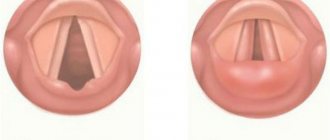Visual impairment is a problem that has no age. Negative changes are observed in both children and adults (elderly). One of the most common is astigmatism. According to medical observations, 6% of school-age children encounter a similar form of mild deviation from the norm. In its serious form, childhood astigmatism is recorded in 40% of patients under 18 years of age. It is necessary to pay attention to the problem, as it negatively affects academic performance and is also a harbinger of myopia.
Astigmatism in children is a refractive error of vision. It occurs with a large load on the cornea, since its sphericity is significantly disrupted, and the lens also suffers, since the refractive properties are distorted. The problem can cause severe vision loss and dizziness. Severe headaches, even migraines, are also recorded. In advanced stages, strabismus is observed. To determine the severity of the problem, a full medical examination and diagnosis using various methods is necessary.
What causes astigmatism in children?
The causes of astigmatism can be divided into 2 large groups - congenital and acquired.
Congenital ones include:
- hypersensitivity to light;
- anomaly in the structure of the skull bones;
- violation of the sphericity of the cornea;
- retinitis pigmentosa;
- intrauterine alcohol poisoning of the fetus.
Acquired is a consequence of:
- conjunctivitis;
- injuries of the skull, cornea;
- burn of the conjunctiva of the eye;
- infectious diseases;
- hyper- and vitamin deficiency;
- subluxation of the lens;
- surgical intervention on the eyes;
- eye diseases;
- violation of the integrity of the walls of the orbit due to dental pathologies;
- development of cataracts.
Causes of occurrence in newborns
Astigmatism is treatable. The sooner it starts, the better. Most children are born with a mild form of the disease, but this is not a pathology: the defect usually disappears by itself by the first birthday.
This disorder is caused by the fact that infants have a strong curvature of the cornea, which gradually normalizes as the eye grows larger.
By school age, only some children have a mild variant. Then it may disappear or remain for life, but it does not require correction.
A serious pathology that requires intervention is transmitted from relatives. It can be easily identified in infants. This is a hereditary disorder that can be passed on even from distant relatives.
In other cases, congenital pathology is a consequence of the development of the eyeball during pregnancy.
The acquired form in children under 1 year of age may be the result of various forms of eye damage or jaw pathology, which subsequently leads to changes in the walls of the orbit.
Also, the presence of other eye problems can lead to the appearance of acquired astigmatism. For the normal development of the eyeball, it is necessary that light penetrates it unhindered in the required volume. For example, if a baby has clouding of the cornea or lens, then the growth of the eyeball will slow down and the curvature will not be corrected. Other diseases can cause the same problem .
Symptoms and clinical picture of astigmatism in children
Manifestations of astigmatism in children include: redness of the eyes, lacrimation, swelling of the eyelids, cloudiness, blurred images, doubling of objects (formation of 2 foci). The presence of the disease can be determined by the following symptoms of astigmatism in children: the baby’s visual acuity decreases, he often squints, brings objects as close to his eyes as possible or leans towards them. Parents should also be concerned if the child cannot concentrate on anything for a long time, is irritable, and often complains of headaches.
General information
Astigmatism is a vision defect associated with pathologies of the optical apparatus of the eye. As a result, the rays lose their ability to be refracted at a certain angle. As a result, they cannot focus on the retina.
Astigmatism refers to a group of diseases associated with visual impairment due to optical defects (ametropia). In this case, there are no pathologies from the eye muscles and the retina itself. All changes are associated with two refractive structures: the cornea and the lens.
The classification of pathology is based on the principle characteristic of all ametropia - this is the severity of visual acuity impairment:
- With mild astigmatism, the sharpness is reduced by no more than 3 diopters.
- The average degree is set when visual acuity decreases in the range from 3 to 6 diopters.
- A severe degree is assigned when the acuity decreases by more than 6 diopters.
The disease with bilateral eye damage is classified into simple and complex variants:
- 1. The first is characterized by a pathology of the same nature on both organs of vision. For example, if there is myopia in the left eye, then the same (albeit to a lesser extent) will also occur in the right.
- 2. Complex astigmatism is characterized by the fact that the types of impairment in both eyes are different: one has farsightedness, and the other has nearsightedness.
Problems of childhood astigmatism
The prevalence of astigmatism among children reaches 40%. This is due both to congenital defects and to the peculiarities of the development of the visual organs in children.
All problems are associated with a number of circumstances:
- age-related features of the eyes,
- mental development,
- the speed of progression of the pathology.
The eye grows rapidly during the first 12 months after birth, and this applies to all its structures. In addition, during this period the baby’s vision is not fully formed. For the first few months, the child is not able to consciously rotate his eyeballs. The very perception of the surrounding world does not occur in the same way as for ordinary people.
The child's eye is not capable of accommodation: objects blur, the clarity of perception decreases.
An important factor is that a baby of the first year of life cannot complain in any way about blurred vision. Firstly, he is not capable of this due to his age (basic lack of speech skills), and secondly, blurred visual perceptions are the norm for the first months of life.
The speed with which pathological changes occur can outstrip all therapeutic measures aimed at preventing and correcting disorders. In addition, the development of the visual organs is inextricably linked with the corresponding parts of the nervous system. Therefore, when visual acuity is impaired, deviations inevitably occur in the development of neurons in the cerebral cortex responsible for processing visual information, which complicates diagnosis.
The main danger of astigmatism is the gradual change in the diameter of the eyeball, as its muscles try to compensate for poor vision by changing the position of the retina. To do this, they either tense or relax. In children, astigmatism can lead to another complication – strabismus. It occurs with varying degrees of pathology in both eyes. Loss of coordination occurs due to uneven contraction of the oculomotor muscles - this condition is then consolidated in neural memory.
Diagnostic methods
Diagnosis of astigmatism in children is based on an assessment of the condition of the eyes and the functionality of the visual system.
For this purpose, the following diagnostic studies are carried out:
- visometry;
- biomicroscopy;
- ophthalmometry;
- ophthalmoscopy;
- Ultrasound of the eyes.
To determine the shape and degree of astigmatism, methods such as autorefractometry, computer keratotopography, skiascopy (shadow test), and keratometry are used.
Modern diagnostic methods make it possible to establish the cause of visual impairment, determine its type, and prescribe adequate treatment. Types of astigmatism: corneal, lenticular, myopic, hypermetropic. There is also a distinction between simple and complex astigmatism, depending on whether the visual function of one or both eyes is impaired.
Reasons for violation
Childhood astigmatism is a congenital visual impairment and in most cases is inherited, but it can manifest itself at almost any age. Quite often, the problem is discovered during a routine examination of children at the age of two years, and already at this time an experienced doctor can make a fairly clear prognosis for the future state of vision in the child.
Sometimes the disorder can be acquired, arising due to the appearance of changes in the cornea, for example, due to rough scars after eye surgery.
The occurrence of astigmatism is caused by the presence of irregularly shaped optical lenses in the eye system. The most common problem is that the natural curvature of the cornea is uneven, and only in isolated cases the reason lies in a violation of the condition of the lens.
The cornea of the eye in a normal state has a spherical shape and the same refractive power in both horizontal and vertical planes. With astigmatism, an imbalance of refractive forces is observed and resonance occurs.
A frequent violation can be called stronger refraction of light rays vertically, with insufficient horizontal refraction. It is as a result of this that the visual outlines of objects become distorted and unclear, regardless of the distance from the child they are located.
The disorder can be nearsighted or farsighted, but mixed forms are also found, when myopia is observed along one axis, and farsightedness is observed along the other.
Quite often, if astigmatism is present to a small extent, a person may simply not notice it, not seeing any special disturbances in visual perception, getting used to the fact that visible objects are slightly stretched or blurred. But it also happens that from infancy a child gets used to seeing the world in this form and then simply does not understand that he has vision problems.
In this case, it is possible to recognize the disease only if, when reading small print or other types of visual strain, for example, sitting for a long time at the computer, embroidering, knitting, the person begins to have a headache and quickly gets tired, and the visible image is often bifurcated.
If detected childhood astigmatism is not treated, the consequences can be different - from strabismus to severe weakening of vision.
Basic treatment methods and contraindications
How to treat astigmatism in children also depends on the degree of vision impairment.
Weak degree of astigmatism. Special glasses are selected.
Average . Restoration of visual function is achieved through surgery and laser correction.
High . Wearing hard contact lenses is recommended.
Cylindrical and spherocylindrical lenses used to correct astigmatism are not prescribed to young children.
Drug therapy is carried out with the aim of stabilizing internal blood circulation in the eyes, normalizing metabolic processes, and eliminating inflammation. Eye drops are prescribed: Taufon, Emoxipin, Albucid.
Diagnostics
Only an ophthalmologist can establish an accurate diagnosis by conducting a thorough examination of the child at an appointment with a mandatory check of his visual acuity using special instruments and tables. Hardware research is necessary to fully identify all the features of visual pathologies. If a violation is detected, the doctor usually prescribes glasses according to the individual needs of the patient, and in the written prescription you can see the values:
- SPH, indicating the required amount of correction of the disturbance in the spherical region;
- CYI, indicating the amount of astigmatism;
- AX indicating its orientation.
Possible complications
Congenital pathology provokes blurriness of objects from the birth of the baby. The problem leads to improper development of the visual system, incorrect functioning of different parts of the brain, because all parts of the human body are closely interconnected. A “breakdown” in one area leads to developmental anomalies as a whole.
The absence of any therapeutic manipulations for astigmatism leads to a decrease in the baby’s visual acuity, resulting in the appearance of amblyopia (an ailment in which vision correction with glasses or special contact lenses will not help restore the normal functioning of the visual organs). If you contact a pediatric ophthalmologist in time, the chances of a positive outcome are much greater.
READ ALSO: Defect of change in shape and axis - hallux valgus in children: photos of pathology, selection of effective treatment methods
Myths about astigmatism
Many people have heard about astigmatism, people believe in various fables. The main myths are given below, do not fall for false information:
- You can't go anywhere without glasses. Some people think that the diagnosis obliges the child to wear glasses all his life. The statement is fundamentally incorrect; modern technologies (laser correction) make it possible to do without glasses. Sometimes the baby outgrows the disease with the help of conservative treatment;
- blueberry-based medicines. The fruit is credited with medicinal properties in the field of vision, but there is no scientifically proven evidence for this phenomenon. Such medications are not used to treat children's ophthalmological problems;
- laser vision glasses Modern technologies provide many ways to get rid of the problem. Manufacturers of such devices claim that the products will eliminate all problems. As in the previous case, no reliable clinical studies were conducted; no positive results or negative effects were identified.
READ ALSO: Why does a child sweat a lot: reasons for the development of pathology and ways to eliminate it
Is it possible to cure the disease?
Astigmatism in children can be cured by the child on their own, most often the process occurs within one year after the onset of the problem. The eyeball is formed before the age of 15, so surgical intervention is recommended only after the age of 18 if the situation worsens.
Moderate and severe forms must be treated, regardless of the presence of symptoms. Such measures ensure the absence of complications and the complete recovery of the baby. The main thing is to identify astigmatism in time and begin to solve the problem.
In some cases, it is difficult to completely cure the pathology, but many patients restore visual function and do not feel any discomfort. It is quite possible to completely get rid of astigmatism only through laser correction.
Why does the skin on a baby’s face peel off and how to deal with it? We have the answer!
The features and advantages of the cocoon mattress for newborns are described in this article.
On the page, find out the instructions for using Bobotik drops for colic in babies.
Causes
Astigmatism can be caused by:
- Heredity – the presence of astigmatism in close relatives.
- Wearing night lenses causes astigmatism. Appears as a complication of using these lenses.
- Trauma – after penetrating wounds of the eyeball, burns of the cornea.
- EEC (extracapsular cataract extraction) - sutures placed on the cornea.
If the cause is heredity, then the pathology is usually detected at an early age. In all other cases, astigmatism appears as a complication and the time of its appearance does not depend on the age of the child.
general information
Astigmatism in a baby is the inability of the eye to focus light rays on the retina, resulting in a defective image. The process starts due to the irregular shape of the front surface of the baby's eye (cornea). Pathology in children is not a disease; the problem is compared to myopia or farsightedness; doctors attribute astigmatism to refractive errors of the eye.
If the pathology is not a disease, then treatment is not necessary; doctors recommend adjustments that improve the baby’s vision and eliminate unpleasant symptoms. Astigmatism can appear at any age, because the child’s body is constantly in the stage of growth and development, and sometimes the retina does not form correctly.
The risk of pathology is present even in infants. In very young children, it is quite difficult to identify the problem, so it is very important to regularly check the vision of young children. Preventive measures will help protect the baby from negative consequences and unpleasant symptoms.












